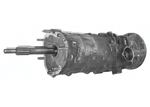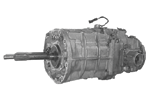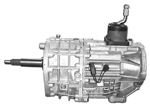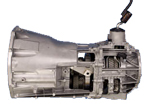by Torque Staff Report
Knowing what axle ratio — commonly referred to as a gear ratio — you have can be very helpful when deciding on larger tires.
If you are unsure of the gear ratio, look for a metal tag held on by two of the differential cover bolts. This tag will have the gear ratio stamped into it. This may not be accurate for used vehicles or vehicles with a history of modifications . Another way to determine the ratio is from the bill of materials stamped into the housing.
An alternate way to be positive of the gear ratio is to remove the cover, count the teeth on the ring gear, and divide by the number of teeth on the pinion gear to get the ratio. Example: 39 Ring Gear teeth / 11 Pinion Teeth = 3.545 or a 3.55 Differential Ratio.
A easy and quick way to get a general idea about the ratio would be the following steps:
- Raise up the rear axle and support it by jack stands.
- Put a chalk mark on the top of the tire and the top of the drive shaft.
- Put the transmission in neutral and spin the rear wheels.
- Count the number of times the drive shaft spins to one revolution of the tire.
Example: If the drive shaft spins 3.5 times to one tire revolution, the ratio would be close to 3.55; 4 times is 4.10; 3 and 3/4 times is roughly 3.73 and so on.
Carrier Breaks:
As the pinion gets smaller with a lower (numerically higher) gear ratio the ring gear has to be moved over to be in contact with the pinion. One way to achieve this is by making the ring gear thicker. Unfortunately, this can only be done to a certain extent. Once the max thickness of the ring gear is reached, the gear carrier must be changed. When these changes are needed, they are referred to as Carrier Breaks, and they are gear ratio specific. The specifics behind this, is that the mounting flange for the ring gear is moved over to allow for proper gear engagement between the pinion gear and the ring gear.
These are typical carrier breaks with the gear ratio range.
Dana 35 3.08 and down, 3.55 and up
Dana 44 4.88 and down, 4.89 and up
*
Here are the common gear ratios for four- and six-cylinder Jeep engines, in both manual and automatic transmissions.
6 Cylinder Engine
|
|
 |
BA-10/BA-5 Peugeot (87'-3/9/89') |
|
|
|
|
 |
AX-15 (89'-99') |
|
|
|
|
 |
NV3550 (00'-04') |
|
|
|
|
 |
NSG-370 (05'-06') |
|
|
|
|
4 Cylinder Engine |
|
 |
AX-5 (87'-02') |
|
|
|
|
| NV1550 (01'-04') |
|
|
|
|
|
 |
NSG-370 (05'-06') |
|
|
|
I




















